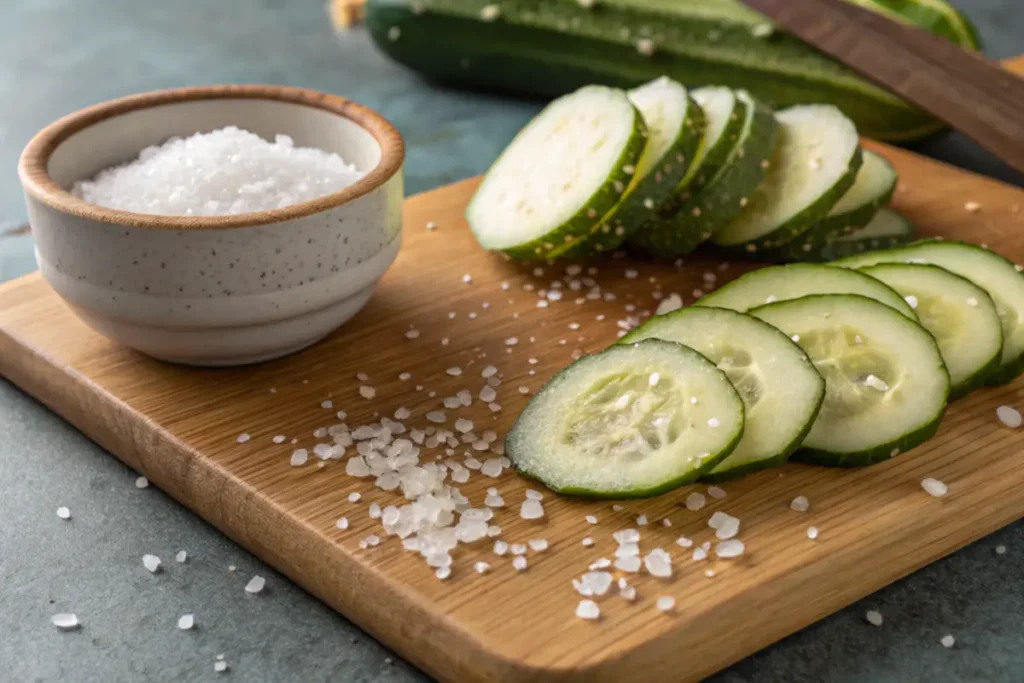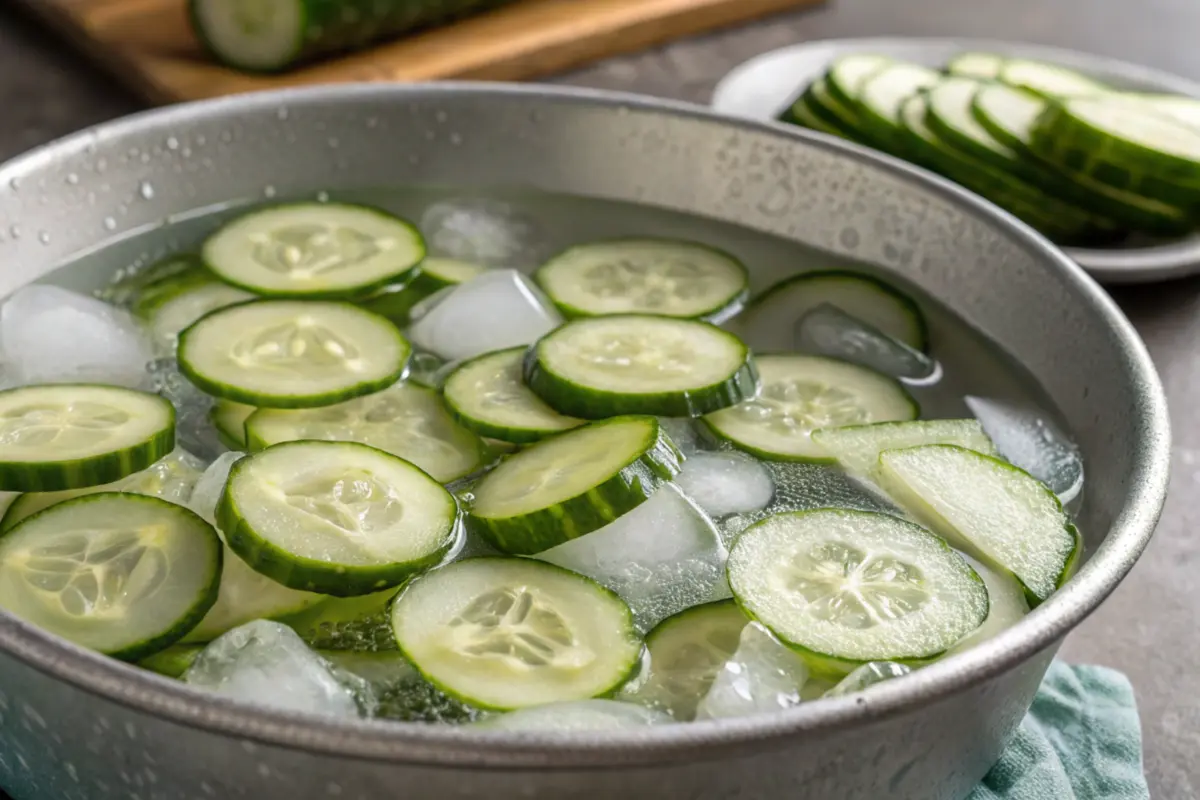Cucumbers are a beloved addition to countless dishes, known for their refreshing taste and delightful crunch. However, getting that perfect crunch can sometimes be challenging, especially when cucumbers begin to soften after being stored. In this comprehensive guide, we’ll explore various methods to make cucumbers more crunchy, while linking it to our primary recipe for a Din Tai Fung-style cucumber dish that can delight your palate.
Why Cucumbers Lose Their Crunch
Before we dive into the solutions, it’s essential to understand why cucumbers lose their crunch. Specifically, cucumbers are composed mostly of water, which makes them highly susceptible to losing their crispness when exposed to improper storage or excess moisture. Consequently, understanding the factors behind this loss can help us better tackle the problem and find effective solutions.
To preserve the crunchy texture of cucumbers, it’s vital to control both moisture and temperature. Therefore, for additional information on preserving vegetables, you might want to check out this guide on vegetable preservation. In addition, you can explore how to store fruits and veggies to maintain freshness here. Moreover, The Kitchn’s guide also provides detailed advice on cucumber storage techniques.
Top Methods to Make Cucumbers More Crunchy
To make cucumbers more crunchy, it is essential to choose appropriate methods that retain or restore their crispness. Here, we have compiled various strategies that work effectively to achieve that. By the end of this guide, you’ll also discover how these methods apply in our popular Din Tai Fung cucumber recipe, ensuring you get the best possible results every time.
1. Choose Fresh Cucumbers
The foundation of having crunchy cucumbers is selecting the freshest produce. Therefore, look for cucumbers that are firm to the touch and have vibrant, dark green skin. Furthermore, avoid cucumbers with soft spots or blemishes, as these indicate age or damage, which will result in less crisp cucumbers.
- Tip: When purchasing cucumbers, try to select those with no yellowing, as this can indicate over-ripeness. Freshness is key to crunchiness!
2. Chill the Cucumbers
Keeping cucumbers at the proper temperature is crucial for maintaining their texture. Therefore, store your cucumbers in a cool, slightly humid environment to maintain their natural crispness. Additionally, remember that temperature fluctuations can affect their texture, so consistency is key.
- Best Practices: Store cucumbers in a plastic bag or wrapped in a damp paper towel in the crisper drawer of your fridge. Ideally, the temperature should be between 50-55°F. Avoid placing them near ethylene-producing fruits, such as apples or bananas, which can accelerate the ripening process.
3. Salt the Cucumbers Before Use

Salting cucumbers before use draws out moisture for a crunchier texture.
Salting cucumbers before using them in a recipe draws out excess moisture, which helps in keeping them crispy once added to your dish. To do this:
- Step-by-Step:
- Slice your cucumbers as needed.
- Sprinkle them generously with salt.
- Let them sit for about 20-30 minutes.
- Rinse thoroughly to remove excess salt, and pat dry with paper towels.
Salting is especially useful if you’re incorporating cucumbers into a dish like our Din Tai Fung cucumber recipe. For a full recipe, including more detailed steps, make sure to check out our complete guide here.
4. Use Ice Water Bath
An ice water bath is one of the most popular techniques for restoring the crunch to cucumbers that have started to soften.
- Instructions:
- Place sliced cucumbers in a bowl of ice water.
- Let them soak for 15-20 minutes to allow them to regain their crispy texture.
Tip: This method works best for cucumbers that will be used in salads or dishes where they are served raw, providing that delightful crunch we all love.
5. Pickling Techniques
Pickling cucumbers can also result in a crunchy texture. If you’re a fan of pickled cucumbers, consider using a cold pickling technique.
- Quick Pickling Process:
- Add cucumbers to a jar with a mixture of vinegar, salt, and water.
- Let the cucumbers soak in the brine for a minimum of 2 hours in the refrigerator.
- This method is ideal for creating a crunchy pickled cucumber, perfect for garnishing a variety of dishes, including our Din Tai Fung cucumber recipe.
For more tips on pickling, you can explore this beginner’s pickling guide to ensure you achieve consistent results.
6. Use Vinegar
Another effective method is to soak cucumbers in a diluted vinegar solution. Vinegar can help maintain the crunchiness of cucumbers by lowering their pH level, which helps inhibit softening enzymes.
- How to Soak:
- Combine equal parts water and vinegar.
- Soak cucumber slices for around 10-15 minutes.
- Rinse well to remove any excess vinegar.
This method is particularly useful if you want to add a hint of tanginess to your cucumbers, which also pairs perfectly with the ingredients in the Din Tai Fung cucumber recipe.
7. Avoid Over-Soaking Cucumbers
While soaking cucumbers can enhance their crunch, it’s essential not to overdo it. Prolonged soaking, particularly in plain water, can lead to sogginess. Moderation is key, especially if you want to ensure that they stay crispy for your main dish.
8. Store Cucumbers with Paper Towels
When storing cucumbers, wrapping them in a paper towel can help absorb any excess moisture, thus keeping them crisp for longer.
- Step-by-Step:
- Wrap each cucumber in a dry paper towel.
- Place them in a plastic bag or an airtight container.
- Store them in the refrigerator.
This is an excellent way to prolong freshness and ensure that your cucumbers are ready for use, particularly if you’re planning to make a batch of Din Tai Fung-style cucumbers.
9. Using Alum in Pickling
If you’re pickling cucumbers and want to ensure they stay crunchy, adding a small amount of alum to the pickling solution can certainly help. Additionally, alum is an ingredient commonly used in traditional pickling, and it effectively helps maintain the firmness of the vegetables. Therefore, using alum can be an excellent way to keep your pickles crisp and enjoyable.
- Caution: Use alum sparingly, as overuse can result in an unpleasant flavor. A ¼ teaspoon is generally enough for a quart of pickling solution.
10. Add Calcium Chloride to Pickling Brine
Calcium chloride is a popular additive in pickling that helps cucumbers stay crisp by strengthening their cell walls.
- How to Use:
- Add a small amount of food-grade calcium chloride (commonly sold as “Pickle Crisp”) to your pickling brine.
- Follow the package instructions for proper usage.
This is a reliable way to keep pickled cucumbers firm and crunchy, making it an excellent choice for those who want consistently crispy pickles.
11. Proper Harvesting Techniques for Garden-Grown Cucumbers
If you grow your own cucumbers, harvesting them at the right time can help ensure their crunchiness.
- Harvesting Tips:
- Pick cucumbers when they are firm and of the appropriate size for their variety.
- Harvest in the early morning when cucumbers are fully hydrated for maximum crispness.
- Avoid letting cucumbers grow too large, as they may become seedy and less crisp.
Harvesting at the right time can make all the difference in maintaining that delicious crunch in your cucumbers.
12. Avoid Wax-Coated Cucumbers
Many cucumbers found in grocery stores are coated in wax to help them retain moisture and extend shelf life. However, this wax coating can sometimes hinder the cucumber’s ability to stay crisp after being cut.
- What to Do:
- Opt for unwaxed cucumbers when possible, such as those labeled as “organic” or sold at farmers’ markets.
- If you must use waxed cucumbers, peel off the waxy skin before preparing them to help maintain their crunchiness.
13. Marinate with Care
Marinating cucumbers can add flavor, but it can also soften them if not done correctly. To maintain crunch while marinating:
- Marinating Tips:
- Use a light marinade with minimal acidic content, as too much acid can break down the cucumber’s structure.
- Limit marinating time to 10-15 minutes to avoid softening.
This method is particularly useful if you’re adding cucumbers to a dish like a salad or appetizer where maintaining their texture is important.
14. Use a Dehydrator for Light Drying
Using a food dehydrator to lightly dry cucumber slices can help maintain their crispness without fully dehydrating them.
- How to Dry:
- Set your dehydrator to a low temperature.
- Place cucumber slices in the dehydrator for 15-20 minutes to remove excess moisture.
This process helps cucumbers retain their crunch when added to dishes or salads.
15. Hydrate Properly Before Use
If your cucumbers seem a little limp, you can rehydrate them to regain some of their crispness.
- How to Hydrate:
- Place the cucumbers in cold water for 30-60 minutes before using them.
- This process helps restore lost moisture and can make cucumbers firmer and crisper.
Hydrating cucumbers can be particularly effective when they have started to lose water during storage.
16. Use Baking Soda in the Soak
Adding a small amount of baking soda to your soaking water can help cucumbers stay crunchy. Additionally, baking soda helps to neutralize any acidity that may cause cucumbers to soften. Therefore, using baking soda is an effective way to ensure that your cucumbers maintain their desired texture.
- How to Use:
- Add ½ teaspoon of baking soda to a bowl of cold water.
- Soak cucumbers for 10-15 minutes.
- Rinse thoroughly before using.
This method can help maintain the cucumber’s texture, especially if you are planning to use them in a salad or for pickling.
17. Use Grape Leaves in Pickling
Adding grape leaves to your pickling jar can help maintain cucumber crunchiness. Grape leaves contain tannins, which help inhibit the enzymes that cause cucumbers to soften.
- How to Use:
- Add a few fresh grape leaves to each jar when pickling cucumbers.
- Ensure the grape leaves are fully submerged in the brine.
This traditional method is a natural way to help keep pickles crisp.
18. Cut Cucumbers Correctly
How you cut cucumbers can also impact their crunch. Cutting cucumbers too thinly can cause them to lose moisture more quickly.
- Tips:
- For salads, slice cucumbers in thicker rounds to help them retain their moisture.
- For pickling, consider spears instead of slices for added crunch.
Proper cutting techniques are important to maximize the crunch in your cucumbers, especially when serving them fresh.
Final Thoughts
Making cucumbers more crunchy is a combination of proper selection, smart storage, and strategic preparation. Whether you’re adding them to a salad, pickling them, or preparing them for a specific recipe like our Din Tai Fung cucumber recipe, the methods outlined above will ensure you get the perfect crunch every time. The key lies in balancing moisture control, temperature, and effective preparation techniques. For more inspiration, check out our complete recipe guide here and explore a variety of creative ways to bring out the best in your cucumbers.
FAQs on Crunchy Cucumbers
1. What makes cucumbers lose their crunchiness?
- Cucumbers lose their crunchiness primarily due to improper storage, exposure to ethylene gas, and over-soaking. Ensuring they are stored correctly and away from ethylene-producing fruits can help maintain their texture.
2. Can you make cucumbers crunchy again once they’ve gone soft?
- Yes, an ice water bath or soaking them in a vinegar solution can help restore the crunchiness of cucumbers that have softened.
3. Are pickled cucumbers always crunchy?
- Pickled cucumbers can be crunchy if the right pickling techniques are used, such as using an ice-cold brine, adding alum, or using grape leaves in the brine.
4. How does calcium chloride help in pickling?
- Calcium chloride helps maintain the firmness of cucumbers by strengthening their cell walls, which keeps them crunchy during the pickling process.
5. Can I use wax-coated cucumbers for pickling?
- It’s best to avoid wax-coated cucumbers for pickling as the wax can prevent proper absorption of the brine. If using waxed cucumbers, make sure to peel them first.
6. What is the role of grape leaves in pickling cucumbers?
- Grape leaves contain tannins that inhibit the enzymes responsible for softening cucumbers, helping to keep pickled cucumbers crunchy.
If you’re looking for the full Din Tai Fung cucumber recipe, including tips on ingredient swaps and serving suggestions, check out our detailed guide here.

